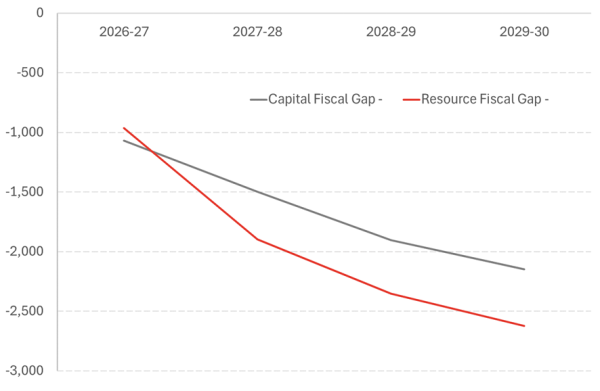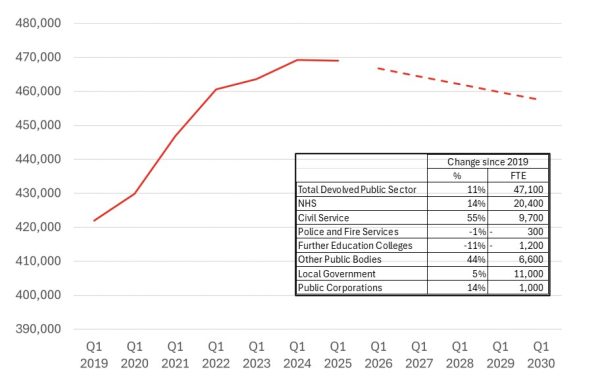The Government published two documents on Wednesday, which together run to over 140 pages. These were the Medium-Term Financial Strategy and the Fiscal Sustainability Delivery Plan. These were presented by Shona Robison to parliament pretty late in the day on Wednesday, so we’ve been digesting them since (see our immediate reaction here).
The MTFS aims to focus on the longer-term sustainability of Scotland’s public finances and support a strategic approach to financial planning. The publication of this document alongside the Spring forecast is supposed to support the year-round budgeting process in Holyrood, allowing the pre-budget scrutiny of committees in the Summer and Autumn to be based on up to date and meaningful information.
However, the MTFS editions to date have not really been successful in achieving these aims. The previous editions appeared to be a strategic document, but in the past has more often than not felt like a political statement, more aimed at managing expectations of what might be funded than in setting out a credible central scenario. One of our criticisms in the past has been that we are not sure how the projections in the document of what might be required for spending were arrived at.
This criticism has been remedied in the version of the document that was published this week. There is detail about how the projected spending has been calculated, which we welcome. [Although, as an aside, both SG and HMT – if you’re publishing a document with loads of tables of figures please make them available in a spreadsheet too…].
There is also a clear strategy that the government want to pursue to deal with funding challenges, along with actions that the government want to take to achieve those aims (contained in linked strategies such as the PSR plan that we discussed last week, and the accompanying Fiscal Sustainability Delivery Plan).
So, overall, it does do a better job than previous editions in setting the context for the year-round budgeting process. There is a chance that that progress was undermined slightly by releasing it in the last week of term, however.
What were the headlines from the MTFS?
Overall, the MTFS presents the funding outlook (i.e. the money the government will have to spend, which is mostly determined by the SR at the UK level and SFC forecasts of other revenues) and compares it with the spending the government thinks it will require. This results in “fiscal gaps” for both resource and capital spending, as shown in the chart below.
Chart : The Resource and Capital “Fiscal Gaps”

Source: SG MTFS
As you can see from the chart, both gaps are projected to grow to over £2 billion by 29-30 (although remember the capital budget will be around £7bn by 29-30 compared to the resource budget’s £45bn so the SG is saying that the gap on the capital side is proportionately much bigger).
The outlook for resource spending was projected using various assumptions. It’s worth saying at the outset that no area of spending is assumed to fall in real terms – all areas are presumed to grow in line with inflation except those areas which are likely to grow more than that, such as:
- NHS spending, which is assumed to grow at over 4% a year, as it has for the last few years;
- Social Security spending which is taking up an increasing proportion of the budget as both devolved benefits become relatively more generous and
- Pay, which is assumed to grow in line with agreed pay deals or, if none currently agreed, in line with the public sector pay policy
- Local government, which is decomposed into social care related expenditure (grown in line with other health spending), pay (grown in line with pay policy) and other spending (grown with inflation).
Obviously pay cuts across NHS and local government, and overall accounts for 55% of the resource budget in the current year.
All of this detail is welcome, but we would encourage the government to publish the full decomposition of the spending assumptions so they can be further scrutinised. The detail given though will allow us to build this decomposition, which we will do over the next few weeks.
What did the Fiscal Sustainability Delivery Plan give us?
The Fiscal Sustainability Delivery Plan set out how some of these challenges were going to be tackled, although there was lots of cross-referencing to previous strategies, such as the public sector reform plan and the NHS Improvement Plan.
One of the most eye-catching commitments was on workforce. The SG has committed to reduce the FTE of the devolved public sector workforce by 0.5 % “on average per annum over the next five years, as part of a shift in workforce plans and operating models because of service re-design, automation, process improvement, re-prioritisation, mergers, and shrinking corporate functions. Frontline services will remain protected as this is taken forward.”
Chart: Devolved Public Sector FTE employment
Source: SG PSE Employment Statistics
As the chart shows, a 0.5% reduction in FTE does not undo the increases that have been seen in the devolved public sector since 2019. And while some of that is due to (e.g.) increased social security powers (which will account for approximately 4,000 of the increase in “civil service” (we assume)), that does not account for the vast majority of it. The table shows that almost half of the increase is NHS.
There are also other actions on efficiencies set out, such as:
- Wider public sector efficiencies and productivity, reform, and revenue raising, with savings growing from £0.6 billion to £1.5 billion per annum over the five years;
- Increasing public value, to be set out in the Scottish Spending Review, with a savings target of between £0.3 billion and £0.7 billion per annum over the five years.
We presume that the first of these is related to the £1billion target set by the PSR plan last week to reduce corporate costs, but it isn’t entirely clear. There are also other commitments in the document, like:
- Deliver NHS Board 3% recurring savings against core funding, supported by a continuous programme of efficiency and productivity opportunities, and enabled by reform.
We’re not clear if this is included in the savings above, an additional saving, or money that will be recycled into other parts of the health and care system. The actual amount this represents is not published.
The detail of these plans is useful to see, although it would be good to see more clarity about how the commitments in the different plans relate to each other. We are not convinced that this needs to be a sperate document, though, and perhaps could be wrapped in with the MTFS in future.
Other stuff in the MTFS annexes
The Scottish Government published the framework for the Scottish Spending Review, which sets out the table for determining the allocations that will be published as part of the Scottish Budget in December.
They have said:
These conclusions will supplement the annual budget and we intend to set out the Scottish Government’s indicative spending plans for 2027-28 and 2028-29 for resource, with an additional year (2029-30) for capital. We will confirm the exact timeframe covered in due course.
The timetable includes a period of stakeholder engagement up to September, which will no doubt be a busy time for organisations to make the case about which services should be prioritised by the government in their decisions in December.
There is also an Annex with information about workforce and pay bill, which the government are committing to publishing on a regular basis. This is a really positive development and we look forward to these being regularly released as statistics.
Authors
Mairi is the Director of the Fraser of Allander Institute. Previously, she was the Deputy Chief Executive of the Scottish Fiscal Commission and the Head of National Accounts at the Scottish Government and has over a decade of experience working in different areas of statistics and analysis.


